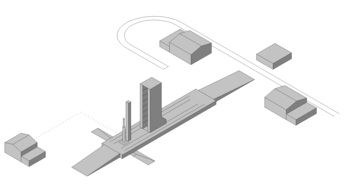Simorgh (rocket)
 The Simorgh space launch vehicle. | |
| Function | Small-lift space launch vehicle |
|---|---|
| Country of origin | Iran |
| Size | |
| Height | 27 m (89 ft) |
| Diameter | 2.5 m (8 ft 2 in) |
| Mass | 87 t (192,000 lb) |
| Stages | 3 |
| Capacity | |
| Payload to LEO (500 km) | |
| Mass | 150 kg (330 lb) [1] |
| Associated rockets | |
| Family | derived from Unha (first stage) and Safir (second stage) [1] |
| Launch history | |
| Status | Active |
| Launch sites | Semnan |
| Total launches | 4 |
| Success(es) | 1 |
| Failure(s) | 3 |
| First flight | 19 April 2016, [1] (suborbital) |
| Last flight | 9 February 2020 [2] |
| First stage | |
| Powered by | 4 × Nodong 2-1 (?) [1] |
| Maximum thrust | 1,300 kN (290,000 lbf) |
| Propellant | RFNA / UDMH |
| Second stage | |
| Powered by | unknown |


Simorgh (Template:Lang-fa, Phoenix), also called Safir-2, is an Iranian expendable small-capacity orbital space launch vehicle,[3]·[4] which was originally scheduled to make its maiden flight in 2010.[5] The project was unveiled by Iranian President Mahmoud Ahmadinejad on 3 February 2010,[6] as part of celebrations of the first anniversary of the launch of Omid, the first indigenously-launched Iranian satellite.[7]
Overview
The Simorgh rocket is 27 metres (89 ft) long, and has a launch mass of 87 tonnes (192,000 lb). Its first stage is powered by four main engines, each generating up to 29,000 kilograms-force (280 kN; 64,000 lbf) of thrust, plus a fifth engine used for attitude control, providing an additional 13,600 kgf (133 kN; 30,000 lbf).[8] At liftoff, these engines generate a total 130,000 kgf (1,300 kN; 290,000 lbf) of thrust. Simorgh was designed to place a 350-kilogram (770 lb) payload into a 500-kilometre (310 mi) low Earth orbit.[1] According to ISNA the engine could be used in future rockets capable of carrying 700-kilogram (1,500 lb) satellites into 1,000-kilometre (620 mi) orbits.[8]·[9]
History
The first flight of the Simorgh rocket was planned to carry Toloo (Sunrise), an experimental imaging satellite. Further launches are expected to carry Mesbah-2 [8] and AUT-SAT [1]. In November 2011, Iran announced that the first flight of Simorgh carrying the Toloo satellite would occur in 2012 from the new Semnan spaceport.[10] Eventually Simorgh flew for the first time on April 19, 2016, for a suborbital test flight whose outcome has not been published. The Toloo satellite was then scheduled for launch in early 2017, according to Head of the Iranian Space Research Center Manouchehr Manteqi,[1] but that launch failed to materialize. A second test launch occurred on 27 July 2017, and failed to reach orbit as the second stage only burned for 20 seconds.[11] The third launch, conducted on 15 January 2019, also failed to reach orbit, due to a malfunction of the third stage.[12]
Launch history
| Flight No. | Date & Time (UTC) | Payload | Type | Outcome | Remarks |
|---|---|---|---|---|---|
| 1 | 19 April 2016 | No Payload | Simorgh | Success | Sub-orbital test flight[13] |
| 2 | 27 July 2017 | No Payload | Simorgh | Failure | Test flight; second stage failed[11] |
| 3 | 15 January 2019 | Payam (named "AUT-SAT" previously)[11] | Simorgh | Failure | Third stage failed[12] |
| 4 | 9 February 2020
15:45 |
Zafar-1[14] | Simorgh | Failure | Satellite fails to reach orbit[15] |
See also
- Comparison of orbital launchers families
- Comparison of orbital launch systems
- International rankings of Iran in Science and Technology
- Asian space race
- Iranian Space Agency
- Safir (rocket)
- Qased (rocket)
- Unha
- al-Abid
References
- ^ a b c d e f g Eshel, Tamir (24 April 2016). "Simorgh First Launch – an Iranian Success or Failure?". Defense Update. Retrieved 25 May 2016.
- ^ https://spaceflightnow.com/2020/02/10/iran-fails-in-satellite-launch-attempt/
- ^ https://spaceflightnow.com/2020/02/10/iran-fails-in-satellite-launch-attempt/
- ^ "Iran brags it launched rocket into space... with mouse, turtles & worms". New York Daily News. 2010-02-03. Retrieved 2010-02-03.
- ^ "Iranian Satellite Launches Slated for 2010". NTI Global Security Newswire. 2009-12-24. Retrieved 2010-02-03.
- ^ Arrott, Elizabeth (2010-02-03). "Iran Announces New Rockets, Satellites on Space Day". VOA News. Retrieved 2010-02-03.
- ^ "Iran unveils new satellites, carrier". PressTV. 2010-02-03. Retrieved 2010-02-03.
- ^ a b c "Iranian DM: Simorgh to Carry Tolou, Mesbah Satellites into Space". Fars News Agency. 2010-02-03. Archived from the original on 2011-11-13. Retrieved 2010-02-03.
- ^ http://www.payvand.com/news/10/feb/1025.html
- ^ "Iran to launch Toloo satellite next year". Iranian Students' News Agency. 2 November 2011. Retrieved 25 May 2016.
- ^ a b c Krebs, Gunter. "Simorgh (Safir-2)". Gunter's Space Page. Retrieved 15 January 2019.
- ^ a b Tawfeeq, Mohammed; Qiblawi, Tamara (15 January 2019). "Despite US warning, Iran launches satellite and fails". CNN. Retrieved 15 January 2019.
- ^ http://defense-update.com/20160424_simorgh.html
- ^ https://spaceflightnow.com/2020/02/10/iran-fails-in-satellite-launch-attempt/ - 11 February 2020
- ^ "Iranian Satellite Launched But Fails To Reach Earth's Orbit". RadioFreeEurope/RadioLiberty. Retrieved 2020-02-09.
